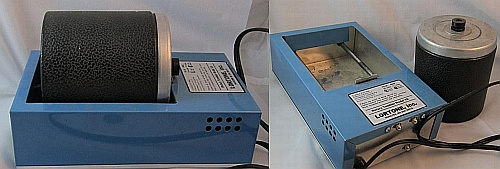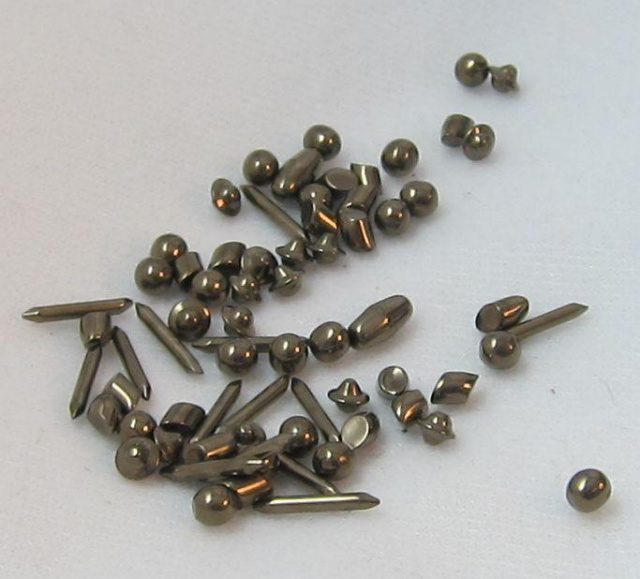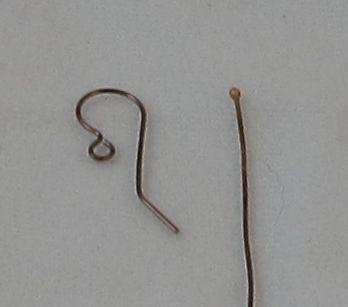Tumbling Jewelry
Karen Meador, Ph.D.,

We’ve received a number of internet queries at Magpie Gemstones (www.magpiegemstones.com) wondering what a tumbler is used for in jewelry making.
This is a brief response to those questions. It is based on practical knowledge rather than internet research.
In other words, this is my opinion which certainly may differ from those of others. The information below relates to tumbling jewelry components and does not discuss how to polish rocks and stones using grit, etc.
A tumbler can work wonders when you’re making jewelry and I use my tumbler several times a day when I’m working in my studio. If you work with wire or metal, a tumbler might just be your best friend. It would be simpler for me to list when I don’t use the tumbler than when I use it.
While I used to fear the outcome of putting pieces into something that would be going round and round for hours, I can now do it without any worry.
What is a Tumbler?
A tumbler consists of a container that can be sealed and opened and an electric motorized bed that turns the container. You can seal steel shot with water and a drop or two of regular Dawn liquid in the container with your jewelry pieces to help clean, polish and work harden them.

Pieces are usually tumbled for several hours. When you have finished tumbling, work over the sink and pour the container contents through a wire mesh strainer with holes small enough that you do not lose your shot. Test the strainer to be sure the holes are small enough; otherwise, you will lose your shot down the sink drain.
Also, run water from the facet over the shot containing your pieces. This will remove all the liquid and then you can dig through the shot to find your pieces.
I leave my steel shot in the strainer between tumbling so that it can air dry. Be careful, however, since I’ve had several disgusting episodes wherein the handle on the strainer was bumped and the shot went flying out. Once the puppy knocked it on the floor and I learned that it’s nearly impossible to sweep up shot that rolls away. Doesn’t he look innocent in the photo?
Another time the shot ended up in the washing machine and I learned that it will go through the rinse cycle without damage. This was a human error. Don’t try this; I think I was just lucky.
I’ve heard of other things to replace the steel shot and know some use a dry tumbling method; however I do not use those and will not discuss them here.
Tumblers and Steel Shot
There are different kinds of tumblers, but I use a Lortone tumbler I’ve had for several years. I originally purchased one pound of mixed steel shot for the tumbler, but friends later suggested I could be more effective using two pounds. I found that this is true and recommend the initial purchase of two pounds of shot.
The shot in the water and regular Dawn liquid obviously rubs against the jewelry components during tumbling.
The shape of the shot determines where it can get on the components and thus where it can help clean and shine. I like to use mixed shot, containing various shapes because the different shapes can fit into the crevices of the components. They do; however, often get caught in these crevices and need to be taken out when the tumbler is finished.
I don’t find that this is a problem; however some people do not use mixed shot for this reason. They prefer shot containing only round pieces.

Tumbler Uses
Use the tumbler for cleaning and polishing wire and metal. I tumble any piece that I have given a patina because it helps to remove the excess and shine the component. This saves some hand work.
You certainly can do this by hand, but I normally patina and tumble several pieces at once and appreciate the tumbler for saving my time and my hands. I also think the tumbler shot cleans in places I might miss. You can tumble copper and sterling silver pieces in the same batch.
I used to question whether it was a good idea to tumble a piece given a patina that also contained a gemstone. For example, I often create bead links with wrapped loops to go in my handmade chain. Also, I may wire wrap a cabochon and then give the wire a patina.
To date, I haven’t had any trouble with tumbling these pieces. If I believe the stone is fragile, I may shorten the length of time it is in the tumbled or simply clean and polish it by hand. Please, however, use your own judgment as I would not want to be responsible for the demise of a precious stone. All the pieces in the photos below have been tumbled.

Link chain and clasp components together. I
f I am tumbling handmade chain and or/ clasps, I link them all together rather than putting each part in as a separate piece. This makes removing the pieces from the tumbler much easier. Otherwise, I spend time digging through the shot to find each little thing.
If I didn’t count the pieces before the tumble, I’m never quite sure if I’ve found them all. I DO NOT tumble purchased chain with small links as I find it becomes impossibly tangled.
I especially like the shine that the tumbler gives sheet metal pieces like those shown below. This saves considerable time that I used to spend polishing bracelets, charms and other components.

Use the tumbler for work hardening.
I put handmade ear wires and balled headpins in the tumbler and feel like it helps strengthen them. I make the balled headpins with my torch. This could, of course, be my imagination, but I feel better about these findings when they have spent several hours in the tumbler.
I use 20 gauge wire for them and would not recommend tumbling anything lighter. The headpins usually come out of the tumbler somewhat bent, but I seldom find one that can’t easily be straightened.
The same can be true for the ear wires; yet, I’ve learned that if I don’t put too many things in the ear wire batch or if I tumble them alone, there is little problem. Just make several of the same size ear wires in case something comes out unusable.

How Long to Tumble
You may question how long to tumble your jewelry components. Most of mine spend between two and four hours on their joy ride. If you are only using one pound of shot, it will take longer. The two to four hour frame is not set in stone.
Often, it is a matter of how long I’m gone on an errand while the tumbler does its magic or how patient I am waiting to retrieve a component and use it. If I open the container and feel my pieces are NOT ready, I just continue for another hour or so. Sometimes I remove some of the pieces and continue to tumble the others.
If you stopped me on the street and asked what I put in the tumbler, my reply would be “just about everything.” I don’t tumble my strung or seed beaded necklaces. If I’m putting a wire or metal pendant on one of these, I tumble it separately and then attach the piece.
Almost all my other pieces do take a tumble. I even force my large metal and wire bracelets and neckpieces into the tumbler and then reshape them later. If you walk into my studio and the tumble isn’t running, I’m probably not working.
I hope the above information will encourage you to give a tumbler a try and to make the most of it. Please don’t hesitate to continue to ask questions and we’ll do our best to answer them at Magpie Gemstones.
Karen Meador
**Contributing authors are noted in the articles they wrote. All articles are copyright. You can reprint these articles as long as the original author is sited and a link to this website is included. The name Magpie Gemstones must be used as the hypertext.